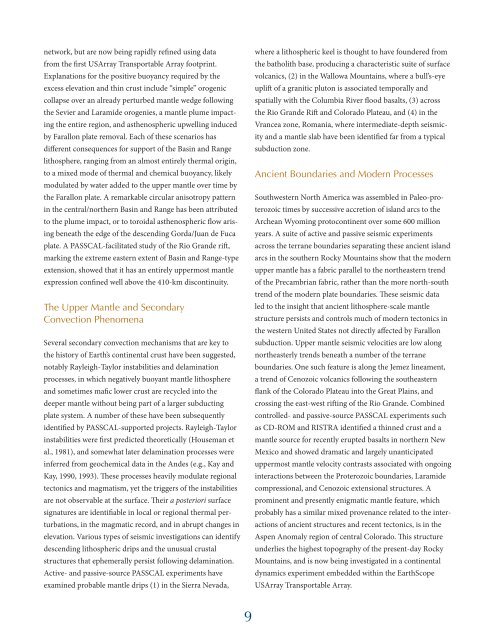Download 9.3 Mb pdf - IRIS
Download 9.3 Mb pdf - IRIS
Download 9.3 Mb pdf - IRIS
You also want an ePaper? Increase the reach of your titles
YUMPU automatically turns print PDFs into web optimized ePapers that Google loves.
network, but are now being rapidly refined using data<br />
from the first USArray Transportable Array footprint.<br />
Explanations for the positive buoyancy required by the<br />
excess elevation and thin crust include “simple” orogenic<br />
collapse over an already perturbed mantle wedge following<br />
the Sevier and Laramide orogenies, a mantle plume impacting<br />
the entire region, and asthenospheric upwelling induced<br />
by Farallon plate removal. Each of these scenarios has<br />
different consequences for support of the Basin and Range<br />
lithosphere, ranging from an almost entirely thermal origin,<br />
to a mixed mode of thermal and chemical buoyancy, likely<br />
modulated by water added to the upper mantle over time by<br />
the Farallon plate. A remarkable circular anisotropy pattern<br />
in the central/northern Basin and Range has been attributed<br />
to the plume impact, or to toroidal asthenospheric flow arising<br />
beneath the edge of the descending Gorda/Juan de Fuca<br />
plate. A PASSCAL-facilitated study of the Rio Grande rift,<br />
marking the extreme eastern extent of Basin and Range-type<br />
extension, showed that it has an entirely uppermost mantle<br />
expression confined well above the 410-km discontinuity.<br />
The Upper Mantle and Secondary<br />
Convection Phenomena<br />
Several secondary convection mechanisms that are key to<br />
the history of Earth’s continental crust have been suggested,<br />
notably Rayleigh-Taylor instabilities and delamination<br />
processes, in which negatively buoyant mantle lithosphere<br />
and sometimes mafic lower crust are recycled into the<br />
deeper mantle without being part of a larger subducting<br />
plate system. A number of these have been subsequently<br />
identified by PASSCAL-supported projects. Rayleigh-Taylor<br />
instabilities were first predicted theoretically (Houseman et<br />
al., 1981), and somewhat later delamination processes were<br />
inferred from geochemical data in the Andes (e.g., Kay and<br />
Kay, 1990, 1993). These processes heavily modulate regional<br />
tectonics and magmatism, yet the triggers of the instabilities<br />
are not observable at the surface. Their a posteriori surface<br />
signatures are identifiable in local or regional thermal perturbations,<br />
in the magmatic record, and in abrupt changes in<br />
elevation. Various types of seismic investigations can identify<br />
descending lithospheric drips and the unusual crustal<br />
structures that ephemerally persist following delamination.<br />
Active- and passive-source PASSCAL experiments have<br />
examined probable mantle drips (1) in the Sierra Nevada,<br />
where a lithospheric keel is thought to have foundered from<br />
the batholith base, producing a characteristic suite of surface<br />
volcanics, (2) in the Wallowa Mountains, where a bull’s-eye<br />
uplift of a granitic pluton is associated temporally and<br />
spatially with the Columbia River flood basalts, (3) across<br />
the Rio Grande Rift and Colorado Plateau, and (4) in the<br />
Vrancea zone, Romania, where intermediate-depth seismicity<br />
and a mantle slab have been identified far from a typical<br />
subduction zone.<br />
Ancient Boundaries and Modern Processes<br />
Southwestern North America was assembled in Paleo-proterozoic<br />
times by successive accretion of island arcs to the<br />
Archean Wyoming protocontinent over some 600 million<br />
years. A suite of active and passive seismic experiments<br />
across the terrane boundaries separating these ancient island<br />
arcs in the southern Rocky Mountains show that the modern<br />
upper mantle has a fabric parallel to the northeastern trend<br />
of the Precambrian fabric, rather than the more north-south<br />
trend of the modern plate boundaries. These seismic data<br />
led to the insight that ancient lithosphere-scale mantle<br />
structure persists and controls much of modern tectonics in<br />
the western United States not directly affected by Farallon<br />
subduction. Upper mantle seismic velocities are low along<br />
northeasterly trends beneath a number of the terrane<br />
boundaries. One such feature is along the Jemez lineament,<br />
a trend of Cenozoic volcanics following the southeastern<br />
flank of the Colorado Plateau into the Great Plains, and<br />
crossing the east-west rifting of the Rio Grande. Combined<br />
controlled- and passive-source PASSCAL experiments such<br />
as CD-ROM and RISTRA identified a thinned crust and a<br />
mantle source for recently erupted basalts in northern New<br />
Mexico and showed dramatic and largely unanticipated<br />
uppermost mantle velocity contrasts associated with ongoing<br />
interactions between the Proterozoic boundaries, Laramide<br />
compressional, and Cenozoic extensional structures. A<br />
prominent and presently enigmatic mantle feature, which<br />
probably has a similar mixed provenance related to the interactions<br />
of ancient structures and recent tectonics, is in the<br />
Aspen Anomaly region of central Colorado. This structure<br />
underlies the highest topography of the present-day Rocky<br />
Mountains, and is now being investigated in a continental<br />
dynamics experiment embedded within the EarthScope<br />
USArray Transportable Array.

















